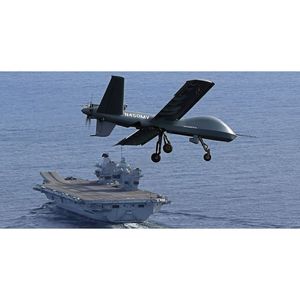General Atomics Aeronautical Systems, Inc. (GA-ASI) conducted a first-of-its-kind demonstration of its short takeoff and landing (STOL) capability on the HMS Prince of Wales, a Royal Navy aircraft carrier, using the Mojave Unmanned Aircraft System. The demonstration took place on November 15, 2023, when the Prince of Wales was underway off the East Coast of the U.S., and the Mojave was controlled by an aircrew within a control station onboard the ship. The demonstration included takeoff, circuits, and approaches and ended with a landing back onto the carrier.
“We applaud the Royal Navy’s foresight in embracing this unprecedented capability for its carriers,” said GA-ASI CEO Linden Blue. “We knew our STOL capability would enable a UAS to safely take off and land on the Prince of Wales. Seeing our Mojave operate successfully in this environment opens myriad new ways our aircraft can be used to support multi-domain naval operations.”
Mojave is a short takeoff and landing UAS demonstrator originally developed to prove STOL operations at unprepared landing sites. While Mojave shares common systems and components with GA-ASI’s Gray Eagle model, a STOL wing set option is likewise being planned for the larger, more capable MQ-9B aircraft, which includes SkyGuardian®, SeaGuardian®, and the new Protector RG Mk 1 currently being delivered to the UK Royal Air Force. The MQ-9B version, called MQ-9B STOL, is being considered by the Royal Navy and other navies that operate aircraft from large flat-deck warships without catapults and arresting gear.
Royal Navy Director Develop, Rear Admiral James Parkin, whose team planned the trial, said: “The Mojave trial is a European first – the first time that a Remotely Piloted Air System of this size has operated to and from an aircraft carrier outside of the United States. The success of this trial heralds a new dawn in how we conduct maritime aviation and is another exciting step in the evolution of the Royal Navy’s Carrier Strike Group into a mixed crewed and uncrewed fighting force.”
Equipping UAS with STOL capability provides greater versatility and allows the aircraft to operate in areas previously deemed unsuitable for UAS operations, including landing onto and taking off from an aircraft carrier. MQ-9B STOL will be capable of carrying the same payloads and conducting the same missions as the SkyGuardian and SeaGuardian, including maritime surveillance, Anti-Submarine Warfare (ASW), Airborne Early Warning (AEW), and surface strike.
 Unmanned Aerial Vehicle The latest drone news
Unmanned Aerial Vehicle The latest drone news


